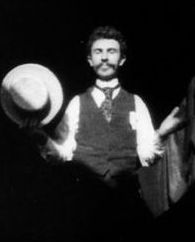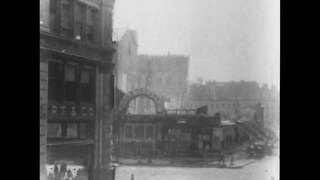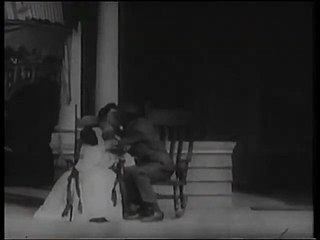Related Research Articles

William Kennedy Laurie Dickson was a British-American inventor who devised an early motion picture camera under the employment of Thomas Edison.

Star Theatre is a 1901 short documentary film in which time-lapse photography is used to show the dismantling and demolition of New York City's Star Theatre over a period of about a month.

The Mutoscope is an early motion picture device, invented by W. K. L. Dickson and Herman Casler and granted U.S. patent 549309A to Herman Casler on November 5, 1895. Like Thomas Edison's Kinetoscope, it did not project on a screen and provided viewing to only one person at a time. Cheaper and simpler than the Kinetoscope, the system, marketed by the American Mutoscope Company, quickly dominated the coin-in-the-slot peep-show business.

The Biograph Company, also known as the American Mutoscope and Biograph Company, was a motion picture company founded in 1895 and active until 1916. It was the first company in the United States devoted entirely to film production and exhibition, and for two decades was one of the most prolific, releasing over 3000 short films and 12 feature films. During the height of silent film as a medium, Biograph was the most prominent U.S. film studio and one of the most respected and influential studios worldwide, only rivaled by Germany's UFA, Sweden's Svensk Filmindustri and France's Pathé. The company was home to pioneering director D. W. Griffith and such actors as Mary Pickford, Lillian Gish, and Lionel Barrymore.

Edison Studios was an American film production organization, owned by companies controlled by inventor and entrepreneur, Thomas Edison. The studio made close to 1,200 films, as part of the Edison Manufacturing Company (1894–1911) and then Thomas A. Edison, Inc. (1911–1918), until the studio's closing in 1918. Of that number, 54 were feature length, and the remainder were shorts. All of the company's films have fallen into the public domain because they were released before 1928.

Herman Casler was an American inventor and co-founder of the partnership called the K.M.C.D. Syndicate, along with W.K-L. Dickson, Elias Koopman, and Henry N "Harry" Marvin, which eventually was incorporated into the American Mutoscope Company in December 1895.

Sherlock Holmes Baffled is an American silent trick film created in 1900 with cinematography by Arthur Marvin. It is the earliest known film to feature Arthur Conan Doyle's detective character Sherlock Holmes, albeit in a form unlike that of later screen incarnations. In the film, a thief who can appear and disappear at will steals a sack of items from Sherlock Holmes. At each point, Holmes's attempts to thwart the intruder end in failure.

The Taming of the Shrew is a 1908 silent film directed by D. W. Griffith and produced by the American Mutoscope and Biograph Company of New York City. The 17-minute short, which is based on the play of the same name by English playwright William Shakespeare, was filmed in just two days–October 1 and 7, 1908–at Biograph's studio in Manhattan and on location in nearby Coytesville, a borough of Fort Lee, New Jersey.
Band and Battalion of the U.S. Indian School is a silent film documentary made on April 30, 1901, by American Mutoscope and Biograph Company made in Carlisle, Pennsylvania, USA. The cinematographer was Arthur Marvin. It depicts a parade drill by the cadet corps of the American Indian School which includes many representatives of the Native American tribes in the United States. The head of the parade was the renowned Carlisle Band of the Carlisle Indian Industrial School. In 1902 Marvin produced another documentary, Club Swinging at Carlisle Indian School for AM&B.

McKinley at Home, Canton, Ohio aka William McKinley at Canton, Ohio is a silent film reenactment of William McKinley receiving the Republican nomination for President of the United States in September 1896. The actual nomination had been several weeks earlier. McKinley is shown emerging from his house to receive the news from his secretary George Cortelyou. His wife Ida can be seen in a rocking chair on the porch. McKinley is seen removing his hat and wiping his forehead with a handkerchief after receiving the news. It was filmed by a two-man crew for American Mutoscope and Biograph Company on 68 mm film, 60.02 m in length. McKinley's brother Abner and former US president Benjamin Harrison were stockholders in the film company.

A Drunkard's Reformation is a 1909 American drama film directed by D. W. Griffith. Prints of the film survive in the film archive of the Library of Congress. The American Mutoscope and Biograph Company advertised the feature as "The most powerful temperance lecture ever depicted".

The Biograph Girl is a musical with a book by Warner Brown, lyrics by Brown and David Heneker, and music by Heneker. Its plot focuses on the silent film era and five pioneers of American cinema - actresses Mary Pickford and Lillian Gish, directors D. W. Griffith and Mack Sennett, and Paramount Pictures founder Adolph Zukor.

2 A. M. in the Subway is a one shot, 53 second-long comedy filmed, and probably directed, by Billy Bitzer on June 5, 1905 at the American Mutoscope and Biograph Company's (AM&B) studio on 14th Street in New York City. Likely intended as a slightly racy, and therefore rather typical, subject for AM&B's peepshow machine, The Mutoscope, 2 A. M. in the Subway is a vignette of New York City's night life that still resonates with New Yorkers more than a century later.
Wallace McCutcheon Sr. was a pioneer cinematographer and director in the early American motion picture industry, working with the American Mutoscope & Biograph, Edison and American Star Film companies. McCutcheon's wealth of credits are often mixed up with the small handful of films directed by his son, Wallace McCutcheon Jr. (1884–1928).

Rip Van Winkle is a 1903 American short black-and-white silent compilation film written and directed by William K.L. Dickson. It is adapted from the play by his friend and investor Joseph Jefferson with Dion Boucicault based on the 1819 story of the same name by Washington Irving.
The Zulu's Heart is an extant 1908 American silent short drama film directed by D. W. Griffith for the American Mutoscope and Biograph Company. Location footage was shot in Cliffside, New Jersey. White actors in blackface portray Zulus.
His Ward's Love is a 1909 American Short film directed by D. W. Griffith and the film was made by the American Mutoscope and Biograph Company.

Santos Dumont Explaining His Air Ship to the Hon. C.S. Rolls is a short film made using a sequence of frames that shows the Brazilian inventor and pioneer aviator Alberto Santos-Dumont explaining the operation of his airship to Charles Rolls, the future founder of Rolls-Royce. It was filmed while Santos-Dumont visited London between 22 and 28 November 1901 and was screened on 3 December the same year, at London's Palace Theatre.

The Widow and the Only Man is a 1904 American short silent comedy film produced by the American Mutoscope & Biograph Company and directed by Wallace McCutcheon, Sr.